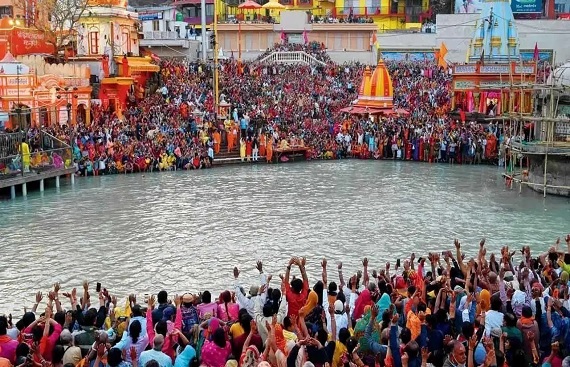Mahakumbh Opens with Rs 25,000 Crore Revenue Projections
By
siliconindia | Monday, 13 January 2025, 10:28:48 AM IST

The 45-day Mahakumbh Mela, formerly known as Purna Kumbh, begins today on the banks of the Sangam in Prayagraj, with the first day expected to see over a million devotees participating in the auspicious occasion of Makar Sankranti. The Uttar Pradesh (UP) government has projected a record-breaking attendance of approximately 400 million visitors between January 13 and February 26, making it one of the largest religious gatherings globally. The event is expected to generate substantial revenue, with forecasts predicting Rs 25,000 crore in government revenue and a staggering Rs 2 trillion in economic spinoffs. This will be supported by a massive contribution from local self-help groups, artisans, hoteliers, homestay owners, food vendors, and national brands such as Dabur, Mother Dairy, and ITC, which are expected to spend a combined Rs 3,000 crore on the event.
The Mahakumbh Mela holds religious significance as it marks one of the largest congregations of people in the world, where devotees come to take a holy dip at the confluence of the Ganga, Yamuna, and the mythical Saraswati river. The government has taken extensive steps to ensure that the event runs smoothly, involving infrastructure development, sanitation, and safety measures. The event is expected to provide a major boost to local businesses, tourism, and employment opportunities in the state.
Uttar Pradesh Chief Minister Yogi Adityanath has emphasized that the Mahakumbh Mela represents a key opportunity for the state’s economic growth. He also highlighted that the event would benefit a wide range of industries, including hospitality, food services, transportation, and retail. According to official estimates, the 2019 Kumbh Mela had already seen the participation of 240 million devotees, setting a benchmark for future gatherings. The current expectations are even higher, with the potential to surpass previous records. The logistical challenges of hosting such a large-scale event are immense, but the state government has initiated several large-scale infrastructure projects to support the needs of visitors. These include building roads, sewage systems, and new facilities to accommodate the anticipated crowd. In 2025, the government has launched 549 infrastructure projects worth Rs 6,900 crore, which include everything from sanitation measures to transportation and health services.
Additionally, the administration has ensured safety measures by establishing a large security apparatus. With an expected crowd of millions, crowd management will be key, especially on the six days of the "shahi snan" (royal baths), including January 13 and February 26. The state government has installed more than 10,000 CCTV cameras and 329 AI cameras to monitor the proceedings and ensure safety. The opening ceremony will also feature 2,500 ‘Make in India’ drones, adding a modern touch to the traditional festivities.
The Mahakumbh Mela is not just an event for religious devotees; it is also a catalyst for economic growth, tourism, and the promotion of "Brand UP" (Uttar Pradesh). Chief Minister Adityanath’s government has emphasized its vision of cultural renaissance through major infrastructure projects like the Kashi Vishwanath Dham corridor in Varanasi and the Ram Temple in Ayodhya, which have already led to a dramatic increase in tourist footfall. For example, the number of visitors to Ayodhya has skyrocketed from just 283,000 in 2016 to an estimated 160 million in 2024, largely due to the construction of the Ram Temple. Similarly, Varanasi saw a surge in tourism, with annual visits growing from 5 million to 60 million following the completion of the Kashi Vishwanath Dham corridor.
The Mahakumbh is expected to replicate the success of the 2019 Kumbh Mela, which is known for its effective crowd management and sanitation measures. In 2019, the administration successfully installed 122,500 toilets, 20,000 dustbins, and 160 waste transport vehicles. Moreover, the state government also experimented with a unique "odour-dispelling solution," which was manufactured daily on-site by student researchers and used in significant quantities to ensure cleanliness throughout the event. As part of its environmental efforts, the government has also planted 300,000 saplings, contributing to the sustainability of the event.
The Mahakumbh Mela is a massive logistical undertaking, with an area spread across 4,000 hectares, which has been designated as the 76th district of Uttar Pradesh for the duration of the festival. This temporary district will feature 56 police stations, 133 police posts, 67,000 streetlights, 7,000 saffron-colored buses to ferry devotees, 1,249 kilometers of water pipelines, and provisions for uninterrupted power supply. A key focus of the government is providing smooth transportation for the millions of devotees expected to arrive. To that end, 100 special trains will be operating to connect Prayagraj with the rest of the country, and the number of flights to the city, along with aircraft parking bays at the Prayagraj airport, has been increased.
In terms of accommodation, the state government has set up 160,000 tents, including 2,200 luxury tents for visitors. In addition, Prayagraj has 218 hotels, 204 guest houses, and 90 dharamshalas, with several homestays offering a more personal touch for visitors. For high-end tourists, there are also premium options like the Dome City, located on the banks of the river, where tariffs can go up to Rs 80,000 per day. These measures ensure that all segments of society, from budget travelers to luxury tourists, have suitable accommodations during the event.
The Mahakumbh Mela is a unique blend of religious significance and economic opportunity, drawing millions of devotees while boosting local and national economies. As the event progresses, it will continue to play a crucial role in showcasing Uttar Pradesh's potential as a major hub for tourism and cultural revival. The successful execution of Mahakumbh 2025 will further solidify the state's ambition to become a $1 trillion economy, while also making significant strides in preserving and promoting India’s cultural heritage. With advanced planning, the event aims to deliver a memorable and safe experience for the millions of people who will make their way to Prayagraj in the coming weeks, cementing its status as one of the most significant spiritual and economic events in the country.
Read More News :

.jpg)
.jpg)
